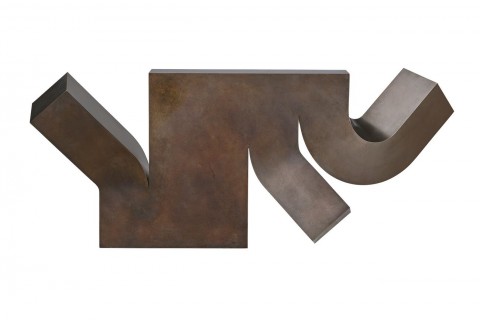WALL FOR BOJANGLES, 1987
CLEMENT MEADMORE
bronze
45.0 x 111.0 x 35.0 cm
signed, dated and numbered at base: Meadmore / 1/6 1987
stamped with Tallix foundry mark at base
Joshua Styrychalski American Paintings, New York
Mary Evangelista, New York
Christie’s, New York, 1 March 2018, lot 44
Private collection, Sydney
Gibson, E., The Sculpture of Clement Meadmore, Hudson Hills Press, New York, 1994, p. 128 (illus. another example)
During the late 1980s, Clement Meadmore created a group works in which the wall was a common theme. Jericho, 1986, Wall Flower, 1989, Wall for Bojangles, 1987 and Wall King, 1988, make up the group. Each of the works appear to have begun with a solid rectangular form, the artist then proceeding to divide and shape portions of the block in his characteristic manner, slicing and shaping in a series of short gestures. Each of the wall sculptures wrestles gently with gravity as it contrasts the weight of the mass against the lightness evoked by the curves and point where it rests.
The titles Meadmore chose offer a direct insight into the artist’s thinking and the challenges he set himself as a sculptor. In this group of sculptures he investigates how a delicate action, such as a curve or a cut, can alter the weight and feel of a larger, dominant form. Wall for Bojangles takes its title from a character of the same name in the 1968 American folk song. Inspired by the tap dancer Bill ‘Bojangles’ Robinson (1878 – 1949) and written by Jeff Walker, the song was popularised by the Nitty Gritty Dirt Band and the many cover versions which followed. Bojangles is in some ways akin to Australia’s swagman, a light footed, hapless hobo, surviving on his wits and opportunity as it presents. In the song we meet him in a prison cell in New Orleans as ’he talks of life’ with his cellmate. He tells his story of life on the road where he made his way as a tap dancer ’for those in minstrel shows and county fairs throughout the south’. For all he lacks in worldly possessions, Bojangles could be the happiest man alive, apart from the death of his dog which ’up and dies, and after twenty years he still grieves’.
It is easy to look at this work and see the connection between the dancer and his moves. The lyrics of the song trip along to a three-four beat and describe in detail Mr Bojangles’ appearance as he clicks and kicks his heels. It is the rhythms of his ’ragged shirt and baggy pants, the old soft shoe’, along with the celebration of movement, where Meadmore gets closest to the ideas he takes from the character.
These wall sculptures communicate a shared sense of movement and with each work presenting as a nonchalant response to the formality of the core sculpture, they march, stride and posture, and in the case of Bojangles – dance. By dividing and twisting the forms Meadmore spreads the weight away from the mass which in this case results in a mood of joie de vivre, in some ways reflecting Mr Bojangles freewheeling life on the road.
HENRY MULHOLLAND
